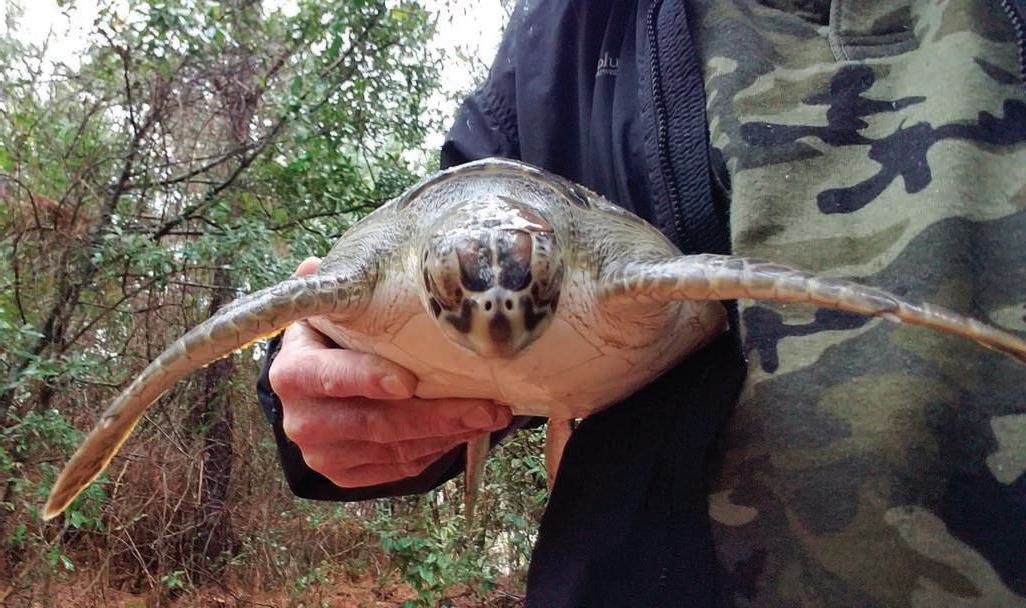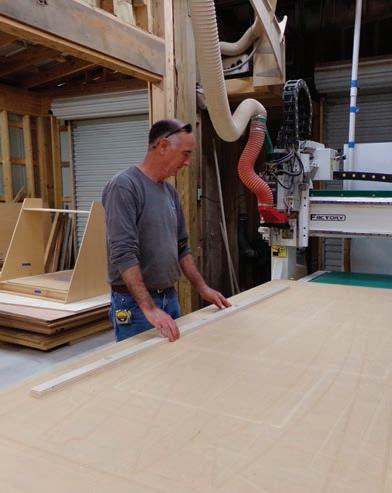
7 minute read
animals in need




HIWR photo
A great horned owl that is waking from anesthesia. It had been hit by a car.
Hatteras Island Wildlife Rehabilitation: Caring for animals in need


HIWR photo
A peregrine falcon in rehab
HIWR photo
Since their feathers are not waterproof, owls do not fl y well in the rain.


by Philip S. Ruckle Jr.
Many times the best thing you can do for a wild animal is leave it alone.
There are, however, times when a wild creature is injured, becomes sick or is orphaned and in those cases, human intervention may be needed to nurse them back to ideal health and release them back out into the wild.
That is what Lou Browning does. As a licensed wildlife rehabilitator in Frisco, he helps care for and treat injured or orphaned animals so they can return to their natural habitat.
It’s a calling that dates back to his childhood years.
“I have always liked working with animals,” Browning says. “When I was a kid I liked all kinds of critters, domestic or wild. And I’ve always had a great curiosity about them.” In North Carolina, permits are required to be able to keep most wildlife species. So Browning took a wildlife rehabilitator class taught by Elizabeth Hanrahan, a rehabilitator already on the island, to get a basic state permit.
“That’s an easy permit to get,” he points out. “Like most rehabilitators, I started working with small animals, small reptiles and other small non-rabies vector animals.”
Because caring for birds requires a federal migratory bird rehabilitation permit, when Hanrahan moved to Edenton, Browning started making the long drive to get birds to her there.
“I was hauling birds to Elizabeth in Edenton and quickly realized I could make trips twice a day seven days a week and not keep up,” he explains. “A federal permit is a pretty intensive thing to get. So I apprenticed with her to get my federal permit for birds. She was a powerhouse type person who was president of the North Carolina Wildlife Rehabilitators for a while, but that was probably a good thing.”
In addition to at least 12 months of supervised rehabilitation activities under a licensed rehabilitator, a formal rehabilitation facility is required for a federal permit. So around 2002, Browning founded Hatteras Island Wildlife Rehabilitation.
“I got my federal permit and started rehabbing down here,” he continues. “And
HIWR photo
An eagle that has seen some hard times and lived through them was a July 4th patient at the Hatteras Island Wildlife Rehabilitation Center.
when I got my federal permit, for the first 10 or 12 years I was doing mainly birds. All kinds of birds.”
Although licensed to work with almost any kind of animal, Browning says he preferred to stick with birds.
“I decided not to do mammals,” he says. “One nice thing about birds is that you don’t have to get up all hours of the night to feed babies. I don’t think mammal rehabilitators sleep. I give them a lot of credit.”
Even with a partially limited clientele, Browning estimates his caseload was up to around 500 a year.
“I was doing all types of birds,” he continues. “It was a full gambit from pelagics to songbirds to loons and quads. Anything and everything along with raptors, songbirds and waterfowl. It was about to wear me out. So about nine years ago I began limiting my work to raptors and reptiles.”
While most of his work is a solo effort, he says during the winter months he works with N.E.S.T. and the Park Service dealing with cold stunned sea turtles and in the summer months he is working with them on sea turtle nests. The rest of the time he specializes on raptors with calls coming in from all across northeastern North Carolina.
“I get calls from Moyock to Columbia and out to Gates County,” he continues. “It keeps me busy.”
Browning went on to say that many of the calls he gets tend to be cases that are more medically intensive. Providing what medical treatment he can within allowable guidelines, Browning has a network of other professionals willing to help nurse and injured wildlife back to health. Places like Roanoke Island Animal Clinic in Manteo and Rocky Point Animal Hospital in Rocky Point, just north of Wilmington.
“Dr. Joni Shimp at Rocky Point is a wonderful resource,” says Browning. “She founded Cape Fear Raptor Center which has become a nationally recognized rehabilitation center specializing in bald eagle rehabilitation and training. She is probably the most experienced veterinarian on the east coast with eagles. So when I get eagles I always confer with her.”
Browning also has others on the island he can call on. Sadly, Hanrahan passed away in 2019, but Rebecca and Richard Marlin are rehabilitators just down the road in Frisco who work with mammals.
“We work pretty close together,” adds Browning.
He says that there are other resources available as well, with numerous training opportunities at various veterinary school symposiums.
“You can always learn a lot there,” he adds. “You need to keep learning and document everything so you can go back to see what did work, what didn’t work and why. There is a lot of on-going training. If you want to be good at it and succeed, you need to keep learning.”
And, while a big part is rehab, another important part is public education.
“Some of that education is simply why a bird is on the beach and why it is okay,”


HIWR photo
Lou Browning listens to a Kemp’s ridley sea turtle’s heart to get a pulse rate.
HIWR photo
A cold stunned green sea turtle being carried from the sound to transport to eventually the Sea Turtle Assistance and Rehabilitation Center at the NC Aquarium on Roanoke Island

Browning continues. “There is also education on why an osprey might be stuck in a nest. We have balloon strings and kite strings that can entangle birds.”
As expected, along with the seasonal influx of visitors is an increase in the number of calls to Browning.
“After Easter there might be 40-60 calls a day,” Browning explains. “It gets busy in the summer when visitors are here. Sometimes multiple calls on the same bird walking the beach. Other times it might be a dozen calls a day.”
Often Browning has to determine from a caller if a bird is actually in need of help. Some cases just require that nature work its course.
Sometimes a call turns out to be a truly unique situation. One such call came last year when an Atlantic puffin was found in Buxton. A small seabird usually associated with more northern locales north of Maine like Iceland and Nova Scotia, the Outer Banks are not considered a routine stop over.
Browning says many of the birds he deals with are suffering some type poisoning, are hit by cars or a combination of those events. Fortunately, there has been success when some good Samaritans follow his instructions to help free a bird or transport it to Browning.
Browning says also that he would like to see less chemical poisoning. Common household poisons and pesticides ingested by rodents can have a disastrous effect on the food chain and even be transmitted to larger wildlife like ospreys and eagles.
“Better to use a snap trap,” Browning says. “That is much more humane.”

HIWR photo
A sad fi nd on the soundside of Hatteras Island. A turtle volunteer found a leatherback with no obvious signs of trauma, so it was not known why it died.



MANTEO,NC|252.473.2449|ELIZABETHCITY,NC|252.335.4395


HIWR photo
Two orphaned great horned owl nestlings















